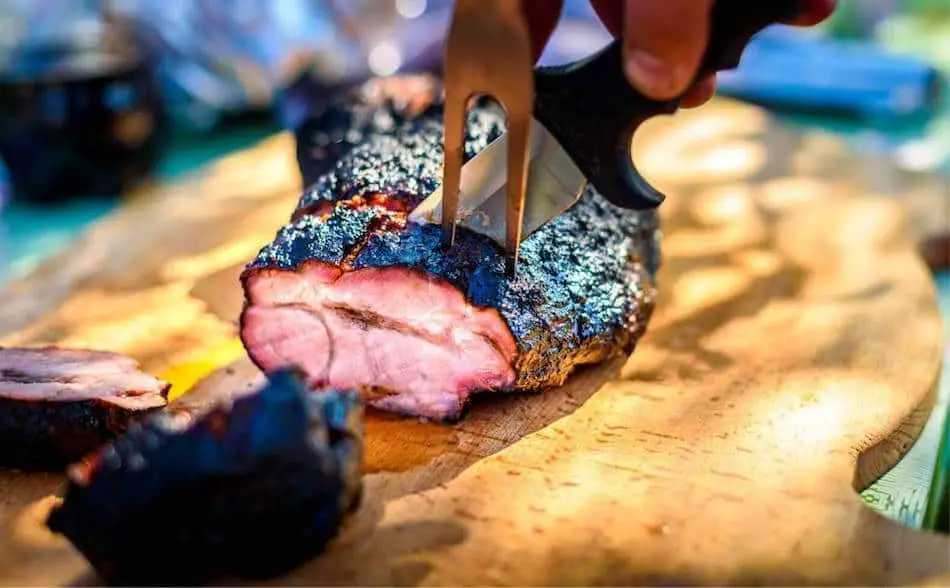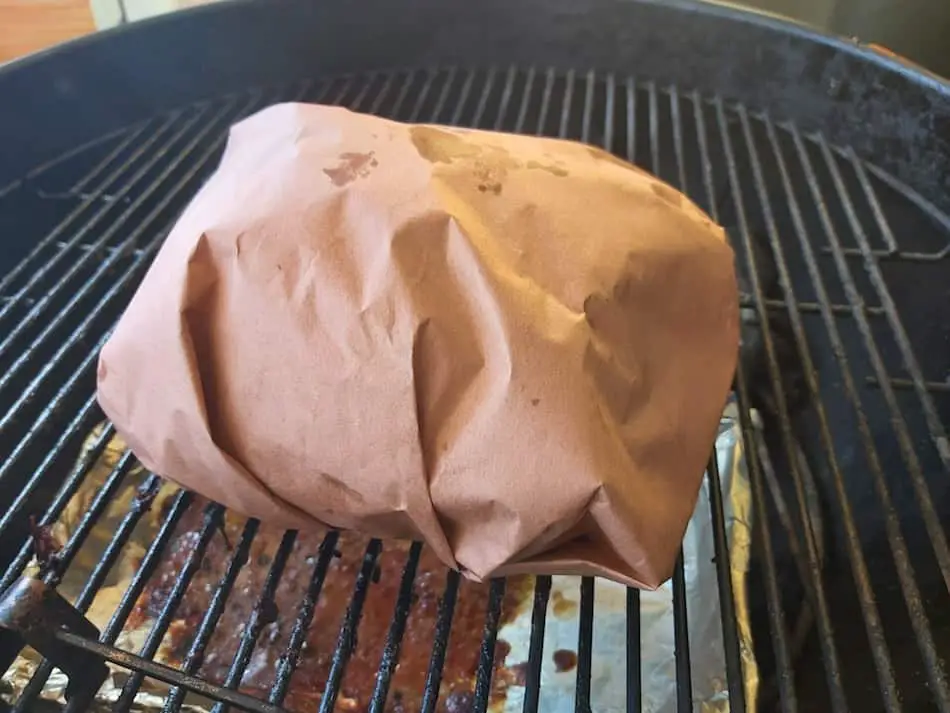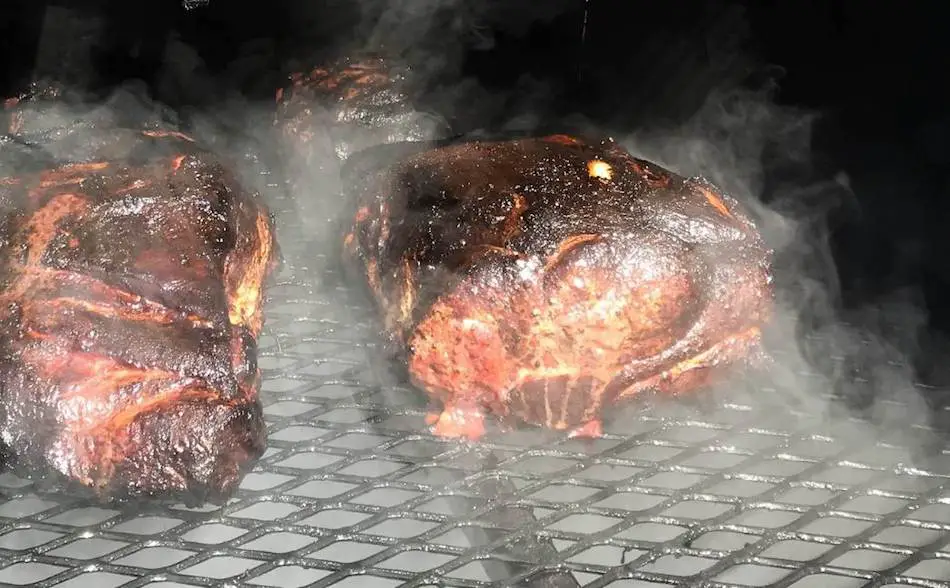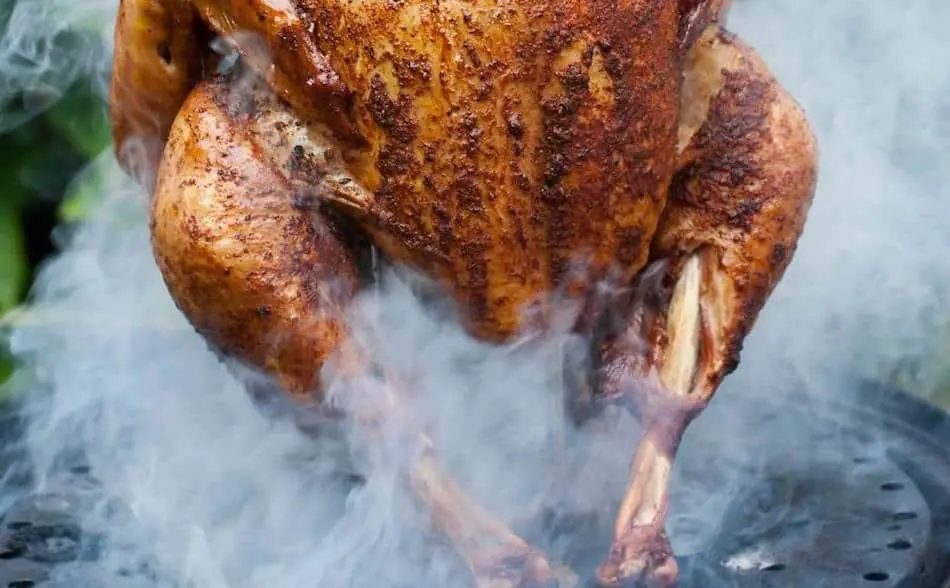
There is nothing quite like the taste of a perfectly smoked piece of meat. However, sometimes things can go wrong, and you can end up with a batch of bitter meat. Bitter smoked is a common problem, but it’s easily avoidable once you understand the causes. In this article, we’ll delve into the causes of bitter smoked meat and provide some tips and techniques for avoiding it in the future. So, if you want to ensure that your next batch of smoked meat turns out perfectly every time, read on!
If your smoker is dirty, your meat may become exposed to creosote, a thick, oily coat that forms when smoke sits on meat for too long. Creosote not only makes smoked meat bitter, but it can also leave an unpleasant aftertaste and cause a tingling sensation in the mouth. In addition to the amount of smoke, the type of wood used can also affect the taste of the meat. For example, using mesquite wood can make the meat taste bitter. It is important to properly balance the smoke, heat, and time when smoking meat in order to create a savory barbeque masterpiece. Too little smoke can result in an outdoor oven, while too much smoke can ruin the flavor of the meat.
Quick Tips
- Creosote: a thick, oily coat formed when smoke sits on meat for too long, causing a bitter taste and unpleasant aftertaste
- Insufficient airflow during the smoking process: allows smoke to sit on the surface of the meat, leading to the formation of creosote
- Over-smoking: exposing the meat to too much smoke, leading to the formation of creosote
- Exposing your meat to smoke from Mesquite can make your meat taste bitter.
- Using contaminated wood: using wood that has been treated with chemicals or painted, causing the smoke to be contaminated and leading to a bitter taste in the meat
- Using too much wood: can cause the meat to be over-smoked, leading to a bitter taste
- Using wood that is too green or wet: can cause the smoke to be too dense, leading to a bitter taste in the meat
- Smoking at too high of a temperature: can cause the fat in the meat to break down too quickly, leading to a bitter taste
- Using wood chips instead of wood chunks: wood chips burn too quickly and can cause the meat to be over-smoked, leading to a bitter taste
- Smoking for too long: can cause the meat to become over-smoked and bitter
- Not properly trimming the fat from the meat: excess fat can cause the smoke to become trapped, leading to a bitter taste
- Using the wrong type of wood: using certain types of wood, such as pine or cedar, can give the meat a bitter taste. It is important to use the right type of wood for the type of meat being smoked.
Why Smoked Meat Can Taste Bitter and How To Prevent It
| Cause of Bitter Smoked Meat | Solution |
|---|---|
| Creosote formation due to poor airflow | Improve ventilation and airflow in the smoker |
| Excessive use of mesquite wood | Use mesquite sparingly or choose a different type of wood |
| Dirty smoker | Clean the smoker before use |
| Meat was not properly trimmed or was too fatty | Trim the fat from the meat or choose a leaner cut |
| Meat was overcooked | Ensure that the meat is cooked to the correct internal temperature |
| Meat was cooked at too high of a temperature | Reduce the cooking temperature to avoid burning the meat |
| Meat was cooked for too long | Adjust the cooking time to ensure that the meat is not overcooked |
| Meat was not properly seasoned | Use a good seasoning blend and apply it evenly to the meat |
Why is My Smoked Meat Bitter?
Your smoked meat is bitter because of a substance known as creosote. Creosote? What’s that, and why does it make my smoked meat taste bitter?
To better understand creosote and why it can wreck the taste of meat, it’s important to understand the process of successfully smoking meat and how creosote can be formed if the proper set-up isn’t in place prior to the smoking process.
The key to properly smoking meat is sufficient airflow. When there is not enough airflow during the smoking process, the smoke then sits on the surface of the meat, and a chemical reaction takes place, causing creosote to form. Creosote is a black, oily substance that is part meat, part rancid smoke. Sounds tasty, right?
To make a layperson’s comparison of what creosote is like, think of the practice of smoking cigarettes and cigars. When outside, in an open-air environment, the smell of cigarette and cigar smoke can smell almost welcoming to a non-smoker.
However, when walking into an apartment, or riding in a car, in which cigarette or cigar smoke has been trapped over a period of time, the non-smoker almost instantly becomes repulsed by the rancid, bitter smell that permeates the environment.
So, essentially, when you try to smoke meat without the proper airflow and ventilation, you are turning your smokehouse into the rough equivalent of a chain smoker’s apartment. But instead of the built-up smoke getting trapped in the wallpaper, it is forming a nasty crust around your precious meat, and instead of smelling the built-up smoke, you have to taste it. Yuck!
Creosote Giving Your Smoked Meat a Bitter Aftertaste?
While the cause of your bitter smoked meat is most likely due to poor airflow, allowing smoke to sit on the meat’s surface and form creosote, it is not 100 percent certain that this is the cause. There are a couple of ways to test and see if creosote is, indeed, the culprit for the bitter taste of your meat.
- Ice water test – take a glass of ice water and hold it in the stream of smoke coming out of your smoker. If the glass starts getting a black, tarry buildup after about a minute of sitting in the smoke stream, then you are exposing your meat to too much smoke and need to improve the ventilation on your smoker.
- Trial test – take a small piece of meat that is not among your prime cuts and put it in the smoker. Take some of the darkest meat and give it a taste, holding it in your mouth for a few seconds. If your tongue starts to get numb and you notice a bitter taste, then that is a telltale sign that creosote has formed on your meat.
Meat Has a Bitter Aftertaste: How Do I Fix It?
Once you have determined that creosote is definitely the cause of your bitter meat, there are a few steps you can take to ensure the nasty substance does not ruin your barbecue masterpiece. You will want to stop creosote before it forms because once it is introduced to your meat, there are not a lot of options to salvage the barbecue.
- Fully open the exhaust vent – most modern smokers will come with an exhaust vent at the top of the device. The vent will look like a small window and should be fully open during the smoking process. This opening will most quickly pull the smoke from the source, past the meat, and out into the open air.
- Stop adding wood to the fire – if you have had trouble with creosote buildup or suspect that creosote may be forming on your meat, then stop adding wood to the fire. This is pretty straightforward as creosote is caused by excess smoke buildup. More burning wood means more smoke being produced.
- Wrap the meat in foil – if you have your vent fully open and still feel like there is too much smoke being produced, you can salvage your barbecue by wrapping the meat in foil. This may not be ideal because you’re less likely to get the smoky barbecue flavor you seek, but it is better to have the foil caked in excess smoke than the meat.
While most smokers will have a vent or multiple vents that can be used to manipulate smoke flow, there are some set-ups where vents are not present. In this case, you will have to monitor your barbeque very closely, applying and removing the lid or cover with great frequency to ensure that the smoke doesn’t sit too long on the meat.

Have you seen the most advanced thermometer on the market? FireBoard can be controlled via your phone, holds meat 6 probes, and records your cook data on a cloud.
Why Does My Smoked Meat Taste Bitter? Other Possibilities
If you’ve made it this far in the article, you have probably checked for the presence of creosote on your meat and taken the necessary precautions to keep it from forming. However, if you’re completely sure that creosote is NOT the culprit for your bitter meat, there may be a couple of other explanations for why your barbecue tastes funny.
- Poor airflow: To properly smoke meat, it is important to have sufficient airflow. Without proper airflow, the smoke will sit on the surface of the meat and a chemical reaction will occur, leading to the formation of creosote.
- Using too much wood: Using too much wood or using wood that is not fully cured can lead to a bitter taste in the meat. It is important to use the right amount of wood and to ensure that it is properly cured before use.
- Using green wood: Using green wood (wood that has not been properly dried) can also contribute to a bitter taste in the meat. It is important to use properly dried wood to avoid this issue.
- Using wood with strong flavors: Some woods, such as mesquite, have strong flavors that can overpower the taste of the meat. It is important to use wood with a subtle flavor that complements the meat, rather than overpowering it.
- Using wood that is too wet: Wet wood can produce more smoke and increase the risk of creosote formation. It is important to use dry wood to avoid this issue.
- Dirty smoker – you should always make sure your smoker is as clean as possible prior to each barbecue, brushing away any excess ash and soot from the grill and walls. While a successful smoke can take place in a dirty smoker, you want to stack the odds in your favor, and if you start clean, your meat is more likely to come out tasting clean
- Burnt sugars in rub – if you like to add a lot of seasoning to your meat prior to cooking, you could be at risk for creating bitter meat. Rubs will cook and burn much faster than the meat itself, so smoking at the wrong temperature causes sugars in the rub to burn before the meat is ready to be served, creating an undesirable flavor.
My Smoked Meat Is Bitter: What Can I Do?
There are those situations when, despite your best efforts, you finish your cook, and the meat tastes bitter. You’ve invested a good amount of time and money into this barbecue, so it’s not just as simple as scrapping the meat and trying again. There are still some ways you can get some good out of bitter meat.
- Trim the creosote – as we’ve ascertained that creosote is the most likely cause of bitter smoked meat, try carefully slicing off all of the dark patches on the outside. While this is not really possible with ribs, thicker cuts, like brisket and pork butt, can still yield plenty of edible surface once the creosote is removed
- Slim down – if the meat is bitter but you are determined to eat it, trim off that creosote and slice as thinly as possible before serving. Pair with a sweet and tangy coleslaw and have a glass of water at hand. Creosote can numb or sting the tongue a bit, too.
- Vinegar bath – there are some haughty grill masters who get offended if you use sauce, feeling like sauce drowns out the barbecue flavor they worked to achieve. However, when the meat is bitter, all the rules are off. Try using a vinegar-based dipping sauce, as the tang is more likely to overpower the bitter than a sweet or neutral sauce.
Get that Thin Blue Smoke and Avoid Bitter Meat
In smoking jargon, grill masters aim to attain what is known as the “thin blue smoke.” This is a faint line of smoke produced from clean-burning wood that flows serenely from the top of the smoker into infinity. This little smoke can go a long way in avoiding the bitter and finishing with a delectable piece of meat. Here’s how to get it.

Control the Temperature
Before introducing meat to the smoker, it is essential that the grill master understands how to control the temperature of his or her pit. The grill master will want to start with a strong bed of hot coals before thinking about adding smoking wood or meat to the pit.
Most smokehouses will come with some small vents, called dampers, at the bottom of the pit, near the burn source, to help with temperature control by adding or reducing oxygen flow to the fire. The bed of coals should be formed from burning down a solid base wood such as mesquite, oak, or hickory.
Successful smoking involves a consistent source of heat over a long period of time, and obtaining this base bed of coals will provide the heat without adding smoke.
An ideal smokehouse will hold a temperature of between 225°F and 250°F for the duration of the smoke. Make sure the bed of coals stabilizes in this range before attempting to add smoking wood or meat.

Cook with the Right Piece of Meat
Having the right piece of meat is half the battle in a successful barbecue. Not only can bad meat taste funny and/or turn out tough, but it may not cook as expected and throw off the timing of a successful smoke.
Ribs should have sufficient meat covering the bone, without too much surface fat. Try to smoke your ribs fresh, as frozen ribs generally don’t turn out as well.
For thicker pieces of meat, look for consistent marbling throughout the body of the flesh. “Marbling” refers to the intramuscular fat that is interlaced in red meat. This will allow the meat to cook down evenly and predictably, giving it a juicy, savory finish.
Meat that is not up to smoking standards can interrupt the “thin blue smoke” by charring prematurely or cooking too slowly, creating the need for more wood and the introduction of excess smoke.
Add Smoking Wood Carefully
To attain the thin blue smoke, the grill master will want to choose his or her smoke wood wisely.
Smoke wood? Isn’t all wood the same?
Smoke wood will be the wood added to the base bed of coals. This wood will burn slowly and should produce a clean, consistent smoke once introduced to the heating source.
As the base bed has already burned down, it will produce little, if any, smoke, making the addition of new wood necessary. There are some things the smoke master needs to avoid when applying smoke wood to the bed of coals:
- No treated or painted woods – this will produce a dirty smoke that will not only make the meat taste bitter, but could also potentially contaminate it and make it unsafe to eat
- No woods high in pitch – woods like pine and cedar will not burn cleanly and can cause the meat to taste bitter
- Start small – adding too much smoke wood right off the bat is a bad idea, as more wood means more smoke, and as we’ve already ascertained, too much smoke can lead to creosote buildup. Add a few chips initially and if more smoke is needed, gradually keep adding until the thin blue smoke is achieved
- No green wood – some grill masters like to soak their smoking chips in water prior to introduction into the smokehouse, which can allow the wood to smoke for longer. However, young wood that still contains a lot of water and green bark can be a disaster, causing excess smoke to billow in the smokehouse.
While grill masters rarely agree on the best type of wood to smoke with, claiming that a number of different woods can be used successfully if the correct smoking process is followed, fruitwoods, such as cherry and apple, are among the most widely used when chasing that thin blue smoke.
Take Your Time
As mentioned in the introduction, successful barbecue requires the perfect balance of heat, smoke, and time. While it’s fun burning things and creating heat and building smoke, the time aspect often isn’t so enjoyable, as it requires patience and a lot of waiting.
Fires, even for the most experienced grill master, can be unpredictable. Due to a variety of factors that may include weather and atmospheric pressure, fires may burn hotter on different days than on others. It’s important that you are patient and make sure not to move ahead with the cook until the coals burn down correctly, even if this takes longer than expected.
Getting in a hurry will also make you feel tempted to throw extra wood on the fire once the meat is on the grate. While this may raise the temperature and possibly make the meat cook faster, you also run an increased risk of producing too much smoke that will cause bitter creosote to form on your meat.
It is also important to remember when cooking larger pieces of meat, such as brisket, that there will be a period known as the “stall.” This is where the temperature on the thermometer doesn’t change, perhaps for hours at a time. This is perfectly natural, so fight the temptation to open the door to your smokehouse to add wood. The glorious breakthrough will come.
Keeping Bitterness Off the Barbecue
Every smoke master aims to attain that beautiful thin blue smoke and share his or her delectable barbecue with those clamoring around the pit to get their plate.
However, there will be occasions, for both the beginner and the veteran grill master, when the meat comes out of the pit tasting bitter. We’ve all been there. To avoid serving bitter meat, run through the ideas above before stepping up to the grill.
Related:
Dry Smoked Brisket? Here’s Why
My Favorite Meat Smoking Tools
Thanks for checking out this article. I hope you learned a few things. Here are some of my favorite tools I use when smoking brisket that may be useful to you. These are affiliate links, so if you decide to purchase any of these products, I’ll earn a commission. But in all honesty, these are the tools I recommend to my family and friends who are just starting out.
Meat Thermometer: There are dozens of fancy thermometers on the market, but I still use my trusty TP20. For around $50, I have a high-quality meat thermometer with two probes, and can track the temperature of my smoker with one probe, and my meat with the other probe. The ThermoPro TP20 is an Amazon Best Seller because it’s the easiest thermometer to operate, is durable, highly accurate, and comes with pre-programmed meat settings.
Instant Read Thermometer: Arguably, the second most important tool you need is a fast and accurate instant-read thermometer. These tools play an important role in the latter stages of the cook when the meat needs regular checking in multiple areas. I use the ThermoPro TP19 because it can do everything a ThermaPen can do, but for a fraction of the cost. You can check out the TP19 on Amazon here.
Wireless Thermometer: The latest thermometers on the market have no wires and can be controlled by wi-fi via your phone. Airprobe 3 is the best of this technology.
Butcher Paper: Wrapping brisket in butcher paper has become a huge trend in barbeque thanks to Aaron Franklin. Wrapping your brisket in paper will give you a nice brisket bark. However, you can’t just use any old paper, it has to be unwaxed, food grade paper. You can find it on Amazon here.
Advanced Thermometer and Automatic Temperature Controller: Once you’re ready to take things seriously, the FireBoard 2 Drive is a six-channel Bluetooth/Wi-Fi thermometer that can monitor up to 6 pieces of meat, control and graph your cook sessions on your smartphone, and attaches to an an automatic blower that will convert your charcoal smoker to a set-and-forget. This is one of the most advanced meat thermometers on the market. You can check it out on the FireBoard website here.
